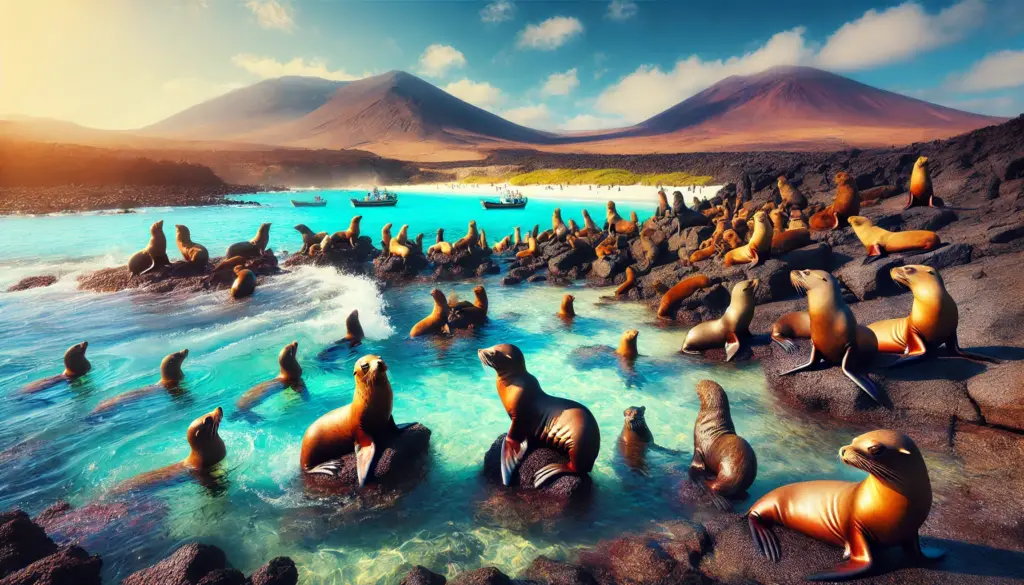Galapagos sea lions are some of the most charming and playful inhabitants of the Galapagos Islands—think of them as the island’s furry party animals, flaunting their unique behaviors and captivating quirks.
In this article, you’re in for a treat as we dive into all the essential scoop about these fascinating marine mammals. We’ll cover everything from their cozy habitats and tasty diets to their social structures and the heroic conservation efforts that keep them thriving.
Get ready to uncover what makes Galapagos sea lions so special, the challenges they face that would make any drama queen gasp, and the efforts being made to protect these remarkable creatures.
Trust me, you won’t want to miss out on this adventure!
What Are Galapagos Sea Lions?
Galapagos Sea Lions aren’t your run-of-the-mill marine mammals; they’re the life of the party in the stunning Galapagos Islands, flaunting quirky adaptations that make them a must-see for wildlife enthusiasts and curious researchers alike.
These adorable critters are endemic, which is just a fancy way of saying they’re exclusive to this paradise and aren’t found anywhere else on Earth—talk about a VIP experience!
With their surprising antics and charming behaviors, they easily charm everyone who’s lucky enough to stumble upon them in their natural playground.
Where Do Galapagos Sea Lions Live?
You’ll find Galapagos Sea Lions living their best lives in the stunning coastal nooks of the Galapagos Islands, where the sea is practically a buffet for these playful creatures.
These charming little furballs love to lounge around on sandy beaches and rocky shores, turning every spot into their personal beach party. Watch as they gather in lively colonies, bringing a splash of energy to these otherwise tranquil and remote habitats.
Who knew nature could be so entertaining?
What Do Galapagos Sea Lions Eat?
Galapagos Sea Lions know how to throw down a feast, diving into a menu that’s mostly fish, squid, and other ocean delights. Talk about a diverse diet!
These savvy swimmers show off their impressive foraging skills, proving they’re not just lounging around on the beach. Their feeding habits are like a masterclass in adaptation, using sharp hunting techniques to snag their meals in the colorful waters surrounding the Galapagos Islands. Who knew dining could be so adventurous?
How Do Galapagos Sea Lions Hunt?
You’ve got to hand it to the Galapagos Sea Lions; they really know how to put on a show when it comes to hunting. With their impressive swimming skills and teamwork that could rival any synchronized swimming team, they’re like the ocean’s version of a well-oiled machine.
Their aquatic agility? Off the charts! They dive deep into the ocean, weaving through intricate underwater mazes in search of fish and squid. Talk about efficient hunters in their vibrant marine playground!
Who knew sea lions could be such overachievers in the animal kingdom?
What Are the Physical Characteristics of Galapagos Sea Lions?
You’ve got to admire the Galapagos Sea Lions with their sleek bodies and those oversized flippers that could probably double as stylish water wings. Their dense fur not only makes them look fabulous but also helps them thrive in their aquatic playground.
And let’s not forget the intrigue of size variations between the males and females—it’s like nature’s way of creating a quirky identity crisis within the vibrant ecosystem of the Galapagos Islands. Who knew survival could look this good?
1. Size and Weight
Galapagos Sea Lions are like the bodybuilders of the animal kingdom, with males tipping the scales at a whopping 800 pounds and stretching over 8 feet long. Meanwhile, the ladies keep it a bit more svelte at around 200 pounds and about 6 feet in length.
These size differences aren’t just for show; they play a crucial role in their social scene. The hefty males strut their stuff, claiming large territories during breeding season and using their impressive girth to send challengers packing. On the flip side, the petite females are the agile go-getters, expertly foraging for food and taking care of the little ones.
This setup not only showcases their physical prowess but also highlights their distinct roles—males flexing their dominance while females focus on nurturing the next generation. Talk about a well-balanced ecosystem!
2. Color and Fur
The fur of Galapagos Sea Lions is like the ultimate fashion statement—typically a chic light brown to golden hue that lets them blend right into their coastal hangouts. It’s not just about looking good; this fur keeps them toasty in those cool ocean waters.
This adaptation is vital for their survival, helping them dodge predators like seasoned ninjas while also holding onto their body heat when temperatures decide to play hard to get. Their fur pulls double duty: insulating them from the sea’s chill and shielding their skin from the sun’s harsh rays.
And when the seasons change, it’s time for a wardrobe refresh! These mammals go through a molting phase, shedding their old fur like they’re tossing out last season’s trends. This staged process ensures they always look sharp and stay snug, letting them thrive in their unique habitat all year long.
3. Flippers and Movement
If you ever had the chance to watch Galapagos Sea Lions in action, you’d be mesmerized by their powerful flippers. These bad boys let them glide through the water like seasoned pros, showcasing swimming skills that are essential for both hunting dinner and dodging dinner—the predators, that is!
Those flippers aren’t just for show; they’re like the ultimate multi-tool for both swimming and strolling on land. With them, sea lions can pull off those sharp turns and lightning-fast sprints to catch their next meal. And when it’s time to catch some rays, those same flippers double as trusty support while they lounge and gossip with their fellow sea lion pals.
Thanks to their unique traits—like a sleek body and a cozy layer of blubber—they’re not just looking good; they’re efficient swimmers too! This combo allows them to dive deep in search of tasty fish and other ocean treats. So, it’s no wonder they thrive in the vibrant ecosystem of the Galapagos.
What Is the Behavior of Galapagos Sea Lions?
You’ve got to admire Galapagos Sea Lions—they’re like the social butterflies of the ocean! With their vibrant antics and playful interactions, they put on quite a show, establishing complex social structures that really showcase their smarts as social creatures.
And let’s not forget their vocalizations and body language; these sea lions are fluent in the art of communication and know exactly how to mark their territory. Who knew marine life could throw such a fabulous party?
1. Social Structure
The social structure of Galapagos Sea Lions is nothing short of a soap opera, with dominant males strutting around like they own the place while females form tight-knit squads, making for some seriously entertaining group dynamics.
In these colonies, you’ll find those macho males barking and posturing like they’re in a talent show, all to maintain their grip on prime breeding spots. Meanwhile, the savvy females are busy foraging and nurturing their pups, sticking together like best friends at a coffee shop. This camaraderie is key—they share tips on where to find the best snacks and warn each other about any lurking predators.
This social scene doesn’t just crank up the breeding success; it also creates a cozy little safety net for the group. The young sea lions have a better shot at survival, soaking up wisdom from their mothers and learning the ropes from their peers as they grow. Talk about a community!
2. Communication
You’d be surprised at how chatty Galapagos Sea Lions can be! These vocal critters have a whole repertoire of sounds, from barks to growls, all serving their social purposes like a well-rehearsed play in their colonies.
Their vocalizations are crucial for keeping the peace and establishing social dynamics—whether they’re claiming territory, wooing a mate, or just figuring out who’s going to take the lead in group activities. For example, high-pitched barks are like their version of “Woohoo!” signaling excitement or alertness, while those low growls? Well, that’s basically their way of saying, “Back off, I mean business!”
But don’t think it stops at sounds! Their body language is a whole other chapter in the communication handbook. The way they position themselves, arch their backs, or tilt their heads can convey messages just as loud as their vocalizations. Together, these sounds and movements create a rich tapestry of interaction that keeps their social structure as vibrant as a sea anemone in a color frenzy.
3. Breeding and Mating
Imagine the Galapagos Sea Lions throwing a wild party every breeding season, where the males are strutting their stuff, competing for the attention of the ladies. It’s like a reality show where they engage in elaborate mating rituals to flaunt their strength and fitness—just picture it!
These guys really know how to make a scene with their vocal performances and physical showdowns, all while setting up their territories to charm the potential mates. It’s not just about flexing those muscles; it’s a clever strategy to keep the gene pool nice and diverse.
Once they seal the deal, the gestation period kicks in for around 11 months, leading to the grand entrance of pups during peak breeding season. Talk about timing! This adds a whole new layer of stress for the mothers. They’re juggling the tough task of feeding their little ones while also keeping an eye out for predators. It’s a full-time job.
These dedicated mamas put in the work to teach their pups essential survival skills, all while navigating the unpredictable world of the marine environment.
What Are the Threats to Galapagos Sea Lions?
Galapagos Sea Lions have quite the list of challenges threatening their charm and survival, don’t they? With habitat destruction, pollution, and the ever-looming specter of climate change, these adorable marine mammals are feeling the pressure.
It’s like trying to enjoy a beach day while dodging a rainstorm—definitely not ideal for these lovable creatures!
1. Human Activities
You’ve got to watch out for how human activities like tourism, fishing, and coastal development mess with Galapagos Sea Lions. These actions can really throw a wrench in their habitat, making those adorable sea lions have to deal with more humans than they’d like.
Sure, tourism can pump some cash into local economies, but it can also spook these furry fellas, throwing off their natural behavior and even their breeding. Plus, if too many people crowd into certain areas, they’re leaving behind pollution and litter—definitely not the kind of beach vibe the sea lions want.
And let’s not forget about fishing; if it’s not sustainable, it can wipe out their food sources and, oops, accidentally snag a few sea lions along the way. Then there’s coastal development, creeping in and taking over their favorite lounging and breeding spots, leaving them with less space to chill.
That’s why it’s super important for everyone involved to champion sustainable tourism practices. If visitors interact responsibly with these marine mammals, we can help keep their populations thriving and protect the delicate ecosystems they call home.
2. Natural Predators
Natural predators of Galapagos Sea Lions, like sharks and those sneaky sea birds, can be a real pain, threatening both the adorable pups and the grown-ups. Talk about a tough start in life!
These predators aren’t just bad news; they actually help keep the ecological balance in check. For example, when sharks are around, sea lions get a little jumpy, which spices up their foraging behavior and social dynamics. Who knew fear could be so motivating?
Adult sea lions become the ultimate vigilantes, adapting their feeding strategies to dodge potential threats, which can make their hunting trips less efficient. And let’s not forget those pesky sea birds during breeding season, which turn sea lion parents into helicopter moms and dads, making them extra protective and affecting how they nurture their little ones.
The drama between these marine mammals and their predators highlights the wild and intricate dance of life in their ecosystems.
3. Disease and Pollution
Diseases and pollution are becoming the bane of Galapagos Sea Lions, turning their lives into a reality show called “Survivor: Marine Edition.” These pesky factors can lead to serious health issues and dwindling populations, which means it’s time to roll up your sleeves for some urgent conservation action.
The impact of these environmental stressors is like a bad hangover for these marine mammals; it messes with their physical health and throws their natural behaviors and romantic escapades into disarray. Think about it: outbreaks of pathogens can knock their immune systems flat, making them easy targets for infections. And don’t get me started on pollutants like heavy metals and plastics—they can throw a wrench in their hormonal systems, which are crucial for breeding and, you know, keeping the next generation alive.
All this trouble can lead to fewer baby sea lions and more heartbreak, putting even more pressure on a population that’s already on the ropes. So, understanding how all these challenges play together is key to cooking up some effective conservation strategies. Time to save the sea lions!
What Are the Conservation Efforts for Galapagos Sea Lions?
Conservation efforts to protect Galapagos Sea Lions are absolutely crucial if you want to see these magnificent creatures stick around for the long haul. Think of it like setting up a VIP lounge for them—marine protected areas and habitat preservation initiatives are the bouncers keeping the riffraff out.
Without these efforts, you might find that your favorite sea lions become a rare sight, and nobody wants that! So, roll up your sleeves and join the cause; it’s time to be their superhero!
1. Protected Areas
Establishing marine protected areas is like rolling out the red carpet for Galapagos Sea Lions, giving them cozy spots where they can kick back and thrive without pesky human interruptions.
These designated zones, including the Galapagos Marine Reserve, are the VIP lounges of the ocean, playing a crucial role in keeping the delicate ecosystems that these fabulous creatures depend on nice and healthy. By putting the brakes on fishing and cutting down on pollution, these areas ensure there’s plenty of grub and perfect spots for our sea lion pals to raise their pups.
Plus, initiatives to preserve their habitats—like keeping invasive species in check and keeping an eagle eye on tourist activities—are key to maintaining these underwater sanctuaries.
All these efforts work together to help an already vulnerable population not just survive, but really thrive, proving that ongoing conservation is the secret sauce for securing their future.
2. Research and Monitoring
Research studies and monitoring programs are your secret sauce for unraveling the mysteries of Galapagos Sea Lions. They’re like the detective work of the marine world, providing you with the juicy data needed to whip up effective conservation strategies.
These initiatives don’t just stop at sea lions; they dive deep into the broader marine ecosystem, showcasing just how critical these furry mammals are to their native environments.
Various scientific efforts zoom in on population trends, analyzing everything from resource availability to those pesky environmental pressures that could rain on their survival parade. Health assessments? Oh, they’re essential for spotting any lurking diseases or stresses that could throw a wrench in the population’s plans, allowing researchers to spring into action with precision.
By mashing together ecological significance and health insights, these studies are like the ultimate team-up, ensuring the long-term survival of Galapagos Sea Lions. And guess what? That’s a win-win for the rich biodiversity of the Galapagos Islands, too.
3. Education and Awareness
Education and public awareness campaigns are the secret sauce for helping you—and everyone else—get a handle on the challenges facing Galapagos Sea Lions while also rallying support for conservation efforts among locals and tourists.
These initiatives are like a bridge connecting scientific smarts to public know-how, making sure you and your fellow beachgoers recognize just how delicate these marine mammals really are. By diving into workshops, guided tours, and interactive seminars, it becomes crystal clear why habitat preservation and responsible tourism practices are the way to go.
These programs turn you into a conservation champion, creating a ripple effect that gets the whole community involved. As more people wake up to how human activities shake up the ecosystem, the collective commitment to protecting species like the Galapagos Sea Lion grows stronger, driving real change.
Frequently Asked Questions
What is the scientific name for Galapagos sea lions?
The scientific name for Galapagos sea lions is Zalophus wollebaeki.
How many subspecies of Galapagos sea lions are there?
There are three recognized subspecies of Galapagos sea lions: Zalophus wollebaeki wollebaeki, Zalophus wollebaeki brycei, and Zalophus wollebaeki galapagoensis.
How long can Galapagos sea lions live?
On average, Galapagos sea lions can live up to 20 years in the wild, but some have been known to reach 30 years of age.
Do Galapagos sea lions have any predators?
Yes, Galapagos sea lions have a few natural predators, including sharks, killer whales, and occasionally Galapagos sharks.
Do male and female Galapagos sea lions look different?
Yes, male and female Galapagos sea lions have distinct physical differences. Males are larger and darker in color, while females are smaller with a lighter, yellowish-brown fur.
How do Galapagos sea lions communicate?
Galapagos sea lions communicate through vocalizations, body language, and touch. They have a variety of barks, grunts, and roars to convey different messages.


